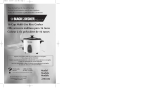
Indented Portion
Overpressure Plug
the cover, until the bottom edge is fully and evenly seated against the underside of the cover (Fig. N). When the
overpressure plug is properly installed, the word (TOP) will be visible on the overpressure plug when viewing
the outside of the cover.
5. To bring out its luster, the outside surface of your pressure cooker can be cleaned
occasionally with a silver polish or any other fine, non-abrasive polish. If food
residue adheres to the pressure cooker body, clean with a vegetable brush, a nylon
pad, or a non-abrasive powder cleanser, such as Bon ami
polishing cleanser or
Cameo
copper, brass & porcelain cleaner. Do not use steel wool or cleaners
with chlorine bleach.
Take care not to overheat your stainless steel pressure cooker. Very high heat
can sometimes cause vari-colored stains, called heat tints, in stainless steel. Heat
tints can usually be removed by using a non-abrasive powder cleanser.
6. When not in use, store your pressure cooker in a dry place with the cover inverted on the body. If the cover is
locked on, unpleasant odors may form inside the unit and the sealing ring could be damaged.
7.
As is the case of all cookware, avoid chopping or cutting food inside the cooker with a knife or other sharp
utensil.
8. If the body or cover handles become loose, tighten them with a screwdriver.
9. The sealing ring, overpressure plug, and rubber gasket of the air vent/cover lock may shrink, become hard,
deformed, cracked, worn, or pitted with normal use. Exposure to high heat, such as a warm burner or oven top,
will cause these parts to deteriorate rapidly. When this happens, replace the sealing ring, overpressure plug, and
small rubber gasket of the air vent/cover lock. Replace the sealing ring and overpressure plug at least every two
years.
Leakage between the cover and body is usually caused by shrinkage of the sealing ring after prolonged use.
Replace the sealing ring. Whenever you replace the sealing ring, replace the overpressure plug also.
10. The formation of a small amount of moisture under the pressure regulator is normal when cooking first begins.
It is the result of the temperature of the regulator being lower than the rest of the unit.
A small amount of steam or moisture may also be visible around the overpressure plug and air vent/cover
lock as cooking begins. It should stop when pressure begins to build and the overpressure plug and air
vent/cover lock seal. If leakage continues, clean or replace the overpressure plug and/or air vent/cover lock
assembly. The pressure cooker will not seal if the gasket for the air vent/cover lock is cracked.
Do not operate your pressure cooker with continual leakage. If the preceding steps do not correct the problem,
return the entire unit to the Presto Factory Service Department (see page 37).
11. If for any reason the pressure cooker cannot be opened, contact the Consumer Service Department in Eau Claire, WI at
1-800-877-0441.
Any maintenance required for this product, other than normal household care and cleaning, should be performed
by the Presto Factory Service Department (see page 37).
Bon ami
polishing cleanser is a registered trademark of Faultless Starch/Bon Ami Co.
Cameo
copper, brass & porcelain cleaner is a registered trademark of Church & Dwight Co., Inc.
Helpful HInTs
Your favorite recipes may be adjusted for cooking in the pressure cooker by following the general directions in
this book for the particular type of food being cooked. Decrease the cooking time for your recipe by
2
⁄
3
since
pressure cooking is much faster than ordinary cooking methods. For example, if your ordinary cooking method
requires 45 minutes, in the pressure cooker the cooking time will be 15 minutes. Because there is very little
evaporation, the amount of liquid used should be decreased. Use about
1
⁄
2
cup more liquid than you’ll desire in
your finished dish. But, remember, there must always be water or some other liquid in the pressure cooker to
produce the necessary steam.
Use the cooking rack when it is desirable to cook foods out of the cooking liquid. When foods are pressure
cooked out of the liquid, flavors will not intermingle. Therefore, it is possible to cook several foods at once, as
long as they have similar cooking times. If it is desirable to blend flavors, do not use the cooking rack.
Fig. N
7























